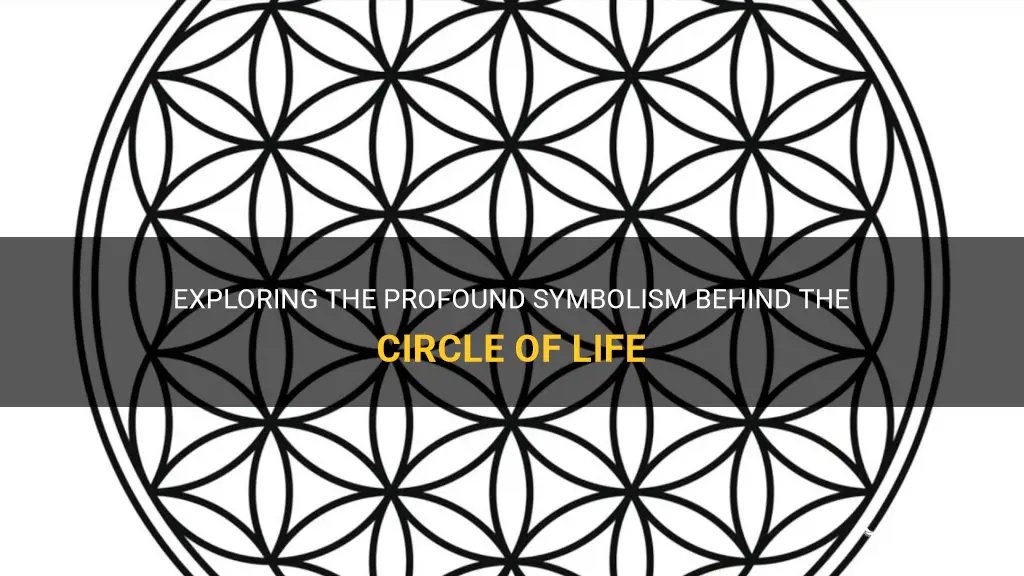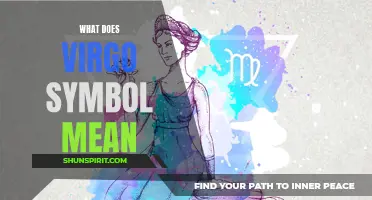
The circle of life symbol is one that holds deep significance and meaning across various cultures and belief systems. It represents the eternal cycle of birth, life, death, and rebirth, and serves as a reminder of the interconnectedness and interdependence of all living things. This powerful symbol can be seen in nature, as well as in spiritual and philosophical teachings, and offers a profound understanding of the continuous flow of energy and existence. Join me as we delve into the fascinating world of the circle of life symbol and uncover its many layers of wisdom and insight.
What You'll Learn
- What is the origin and cultural significance of the circle of life symbol?
- How does the circle of life symbol relate to the concept of rebirth and renewal?
- Are there any specific animals or elements commonly associated with the circle of life symbol?
- In what ways do different cultures interpret and adapt the circle of life symbol?
- How does the circle of life symbol connect to broader philosophical or spiritual beliefs?

What is the origin and cultural significance of the circle of life symbol?
The circle of life symbol is a concept that has been present in many cultures throughout history. It represents the interconnectedness and cyclical nature of life, death, and rebirth. This symbol can be found in various religious, spiritual, and philosophical traditions.
One of the oldest references to the circle of life can be traced back to ancient Egypt. The Egyptians believed in the concept of eternal life and viewed the circle as a representation of the afterlife. They believed that life was a continuous journey and that death was only a transition to the next phase of existence. This belief influenced their funerary practices and the construction of elaborate tombs and burial sites.
In Native American cultures, the circle of life is an important symbol that represents the harmony and interconnectedness of all living beings. Many tribes believe in the concept of the Medicine Wheel, a sacred circle that represents the different aspects of life, such as the four seasons, the four cardinal directions, and the four stages of life (birth, adulthood, old age, and death). This symbol is used in various ceremonies and rituals to honor and celebrate the natural cycles of life.
The circle of life is also a prominent symbol in Buddhism, where it is known as the Wheel of Life or Bhavachakra. This symbolizes the cycle of birth, death, and rebirth, as well as the continuous process of suffering and liberation. The Wheel of Life is often depicted with various realms or realms of existence, representing the different states of being that an individual can experience based on their actions and karma.
In addition to its religious and spiritual significance, the circle of life symbol has also been embraced by popular culture. It gained widespread recognition through Disney's animated film "The Lion King," in which the character Rafiki sings about the circle of life and its importance in the African savannah. The film portrays the interconnectedness of all living beings and the importance of respecting and preserving the natural world.
Overall, the circle of life symbol has deep cultural and spiritual significance in various traditions around the world. It serves as a reminder of the cyclical nature of existence and the interconnectedness of all living beings. Whether as a representation of the afterlife, a symbol of harmony, or a metaphor for the human experience, the circle of life is a powerful and enduring symbol that continues to resonate with people of all backgrounds.
Deciphering the Symbols on Your Danby Dehumidifier: What Do They Mean?
You may want to see also

How does the circle of life symbol relate to the concept of rebirth and renewal?
The circle of life symbol has deep-rooted significance in various cultures and religions around the world. It represents the constant cycle of birth, death, and rebirth that is inherent in nature. This concept of the circle of life is often associated with renewal, transformation, and the cyclical nature of existence.
In many belief systems, the circle of life is seen as a universal truth, applicable to all living beings. It serves as a reminder that life is a continuous cycle, and that death is not the end, but rather a transition to a new phase of existence. Just as the seasons change and bring new life after the onset of winter, so too does the circle of life symbolize the constant renewal and rebirth of life.
Symbolically, the circle represents wholeness, unity, and completeness. It has no beginning or end, illustrating the infinite nature of the cycle of life. The cycle consists of various stages, each with its own purpose and significance. Birth represents the start of the cycle, while death serves as the end. However, death is not the final destination, as it leads to rebirth and renewal. The circle of life symbolizes the idea that all life is interconnected and part of a greater whole.
The concept of rebirth and renewal is also closely related to the idea of karma and reincarnation in many Eastern religions. According to these beliefs, an individual's actions in one life determine their fate in the next. By living a virtuous life and accumulating good karma, one can break free from the cycle of rebirth and achieve enlightenment or nirvana. This journey of rebirth and renewal continues until one reaches a state of liberation from the cycle.
Moreover, the circle of life symbol can also be seen in the natural world. The changing of the seasons, the growth and decay of plants, and the life cycles of animals all exemplify the concept of rebirth and renewal. In spring, dormant plants come back to life, and animals give birth to their young, symbolizing the rebirth and renewal of life. These natural processes serve as reminders of the cyclical nature of existence and the constant opportunity for growth and transformation.
In conclusion, the circle of life symbol represents the continuous cycle of birth, death, and rebirth that is inherent in nature. It embodies the concept of renewal and transformation and serves as a reminder that life is a continuous journey. The symbol is deeply rooted in various cultures and religions, emphasizing the interconnectedness and cyclical nature of all life. Whether through the changing of the seasons or the belief in karma and reincarnation, the circle of life symbolizes the constant opportunity for rebirth and renewal.

Are there any specific animals or elements commonly associated with the circle of life symbol?
The concept of the circle of life is a widely recognized symbol that represents the interconnectedness and continuity of all living things. It is seen in various cultures and beliefs across the world, and often represents the cyclical nature of birth, life, death, and rebirth.
While there are no specific animals or elements that are universally associated with the circle of life symbol, there are some that are commonly used to represent different stages of the cycle.
One animal that is often associated with the circle of life is the lion. Lions are often depicted as symbols of power, strength, and majesty. They are seen as the kings of the animal kingdom and are known for their ability to protect and provide for their pride. Lions also play a vital role in the ecosystem as top predators, helping to maintain a balanced and healthy environment.
Another animal that is commonly associated with the circle of life is the phoenix. In Greek mythology, the phoenix is a mythical bird that is cyclically regenerated or reborn. It represents the idea of death and rebirth, as it is said to be consumed by fire and then resurrected from its ashes. The phoenix symbolizes the eternal cycle of life, death, and renewal.
In addition to animals, certain elements are also associated with the circle of life symbol. One of these elements is water. Water is essential for life and is often seen as a symbol of purification, renewal, and transformation. It represents the idea that life is constantly evolving and changing, just as water flows and moves in a cyclical manner.
Another element that is associated with the circle of life is the sun. The sun is often seen as a symbol of life, warmth, and vitality. It represents the idea of light and growth, as it provides energy for plants to grow and nourish all living beings. The sun also rises and sets every day, symbolizing the cyclic nature of life.
Overall, while there are no specific animals or elements that are universally associated with the circle of life symbol, the lion, phoenix, water, and sun are commonly used to represent different aspects of the cycle. These symbols help to convey the idea of interconnectedness, continuity, and the cyclical nature of life and death.
Exploring the Rich Symbolism and Meanings Behind Filipino Tribal Tattoos
You may want to see also

In what ways do different cultures interpret and adapt the circle of life symbol?
The circle of life is a powerful symbol that represents the continuous cycle of birth, growth, death, and rebirth. It has been interpreted and adapted by various cultures around the world, each adding their unique perspective and meaning to the symbol.
One of the most well-known interpretations of the circle of life comes from Native American cultures. They believe in the interconnectedness of all living things and see the circle as a representation of this concept. In their interpretation, the circle represents the cycle of life, where every living being is born, grows, and eventually dies, only to be reborn again. This belief is deeply rooted in their spirituality and is often associated with the concept of the "Great Spirit" or the divine force that governs the universe.
In African cultures, the circle of life symbol is also widely recognized and interpreted in various ways. In many African tribes, the circle represents the cycle of seasons and agricultural cycles. It symbolizes the natural rhythms of the earth, where crops are planted, nurtured, harvested, and then replanted again. The circle of life, in this context, is seen as a metaphor for the continuous cycle of growth and abundance.
In Chinese culture, the circle of life is often associated with the concept of yin and yang. Yin and yang are complementary forces that exist in harmony and are present in all aspects of life. The circle represents the continuous interplay and balance between these opposing forces. It symbolizes the constant cycle of creation and destruction, as well as the cyclical nature of change and transformation.
In Hinduism, the circle of life is known as the concept of "samsara." Samsara represents the continuous cycle of birth, death, and rebirth that all living beings go through. In this interpretation, the circle symbolizes the eternal recurrence of life, where the soul is reincarnated in different forms until it achieves enlightenment or liberation from the cycle.
These are just a few examples of how different cultures interpret and adapt the circle of life symbol. While the basic concept remains the same, each culture adds its unique perspective and meaning to the symbol, reflecting their beliefs and values. The circle of life is a universal symbol that transcends cultures, reminding us of the interconnectedness and cyclical nature of all living things.
The Fascinating World of Peruvian Symbols and Their Meanings
You may want to see also

How does the circle of life symbol connect to broader philosophical or spiritual beliefs?
The circle of life is a powerful symbol that connects to broader philosophical and spiritual beliefs. This symbol represents the continuous and cyclical nature of life, with birth, death, and rebirth as integral parts of this perpetual cycle. It is a concept that has been embraced by various cultures and religions throughout history and holds deep significance and wisdom.
In many philosophical traditions, the circle of life represents the interconnectedness and interdependence of all things. It symbolizes the idea that everything in the universe is part of a greater whole, and that the actions and choices of one individual or organism can have far-reaching effects. This concept is often associated with the Eastern philosophy of Taoism, which emphasizes living in harmony with the natural flow of life and recognizing the interconnectedness of all beings.
From a spiritual perspective, the circle of life embodies the belief in the immortality of the soul or spirit. Many spiritual traditions, such as Hinduism and Buddhism, subscribe to the idea of reincarnation, where the soul is believed to be reborn into a new body after death. This cycle of birth, death, and rebirth continues until the soul achieves spiritual enlightenment or liberation from the cycle of samsara.
The circle of life also serves as a reminder of the impermanence of life and the inevitability of death. It encourages individuals to embrace and accept the transitory nature of their existence and to appreciate the preciousness of each moment. This perspective can be found in various spiritual practices, such as meditation and mindfulness, which aim to cultivate a deep awareness and acceptance of impermanence.
Furthermore, the circle of life symbolizes the idea of balance and harmony. Just as day follows night and spring follows winter, the circle of life reminds us that life is a constant cycle of ups and downs, joys and sorrows. It encourages individuals to find equilibrium in their lives and to navigate through the inevitable challenges and changes with resilience and grace.
In conclusion, the circle of life symbol connects to broader philosophical and spiritual beliefs by embodying concepts such as interconnectedness, immortality of the soul, impermanence, and balance. It serves as a powerful reminder of the cyclical nature of life and offers profound wisdom and guidance for those who contemplate its meaning. By embracing this symbol and its associated teachings, individuals can gain a deeper understanding of themselves, their place in the universe, and their connection to all living beings.
Unveiling the Symbolism and Meaning Behind Cloud Shapes
You may want to see also
Frequently asked questions
The circle of life symbol represents the idea that life is a continuous and cyclical process. It symbolizes the interconnectedness of all living beings and emphasizes the notion that life is constantly evolving and moving forward. In many cultures and religions, the circle of life represents the journey of birth, growth, death, and rebirth.
Some common symbols associated with the circle of life include the sun, moon, and stars, which represent the celestial aspect of the cycle. Other symbols may include the tree of life, which symbolizes growth and regeneration, as well as various animals that represent different stages of life or embody certain qualities, such as the butterfly symbolizing transformation and the eagle symbolizing strength and freedom.
The circle of life symbol can be a reminder to embrace change and to find meaning and purpose in every stage of life. It encourages individuals to appreciate the interconnectedness of all living things and to recognize the importance of balance and harmony. It can also serve as a reminder to live in the present moment and to appreciate the beauty and fragility of life. By understanding and embracing the circle of life, individuals can gain a deeper perspective and appreciation for their own journey and the journeys of those around them.







